Common fish that start with the letter “M” include mackerel, mackerel shark, mahi-mahi, mahseer, mail-cheeked fish, mako shark, mandarinfish/mandarin Goby, manta ray, marbled lungfish, marlin, masu salmon, medaka, megamouth shark, menhaden, and merluccid hake. Read on to learn more about these amazing fish!
With more than 30,000 known species and more being discovered all the time, fish are the most diverse group of vertebrate animals on the planet! From cartilaginous mako sharks and manta rays to bony fishes as small as minnows, let’s explore more than 30 unique fish that all have at least one thing in common: the first letter of their common name, in this case, M!
1. Mackerel (Scombridae family and Scombrini tribe, 30+ species)

The
king mackerel
is one of around 30 total mackerel species.
©Coastal Girl/Shutterstock.com
Perhaps one of the most well-known fish starting with the letter M is the mackerel, which is the common name for more than 30 unique species. Most mackerel species are part of the Scombriade family, which also includes tunas and bonitos. Mackerels are, however, much smaller and more slender than most tuna species. They are fast swimmers and expert hunters that mainly feed on crustaceans and other, smaller fish.
2. Mackerel Shark (2 species, Lamna genus)
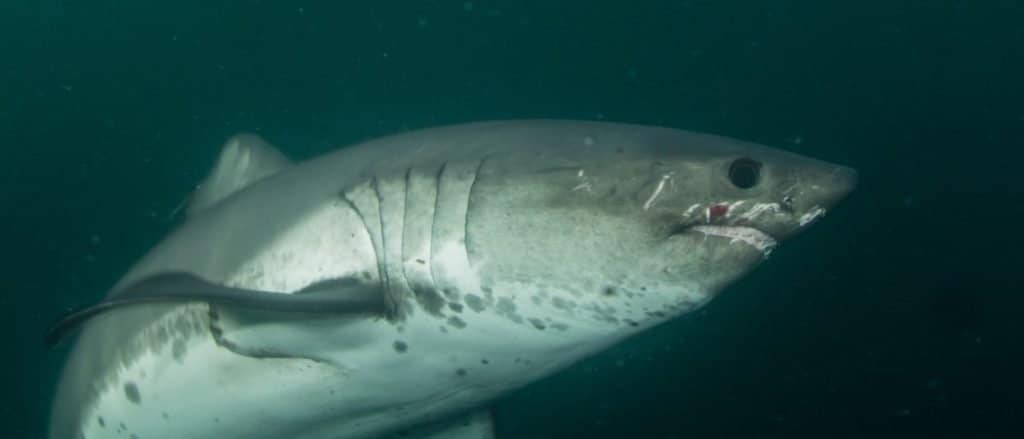
The salmon shark is one of just two species of mackerel sharks.
©Warren Metcalf/Shutterstock.com
There are two main species of mackerel sharks: the salmon shark and the porbeagle shark. These sharks are mainly unique for their ability to regulate the temperature of their blood, similar to that of warm-blooded animals. The only other fish able to do this are a handful of other very large, speedy species, most notably the swordfish.
3. Mahi-mahi (Coryphaena hippurus)
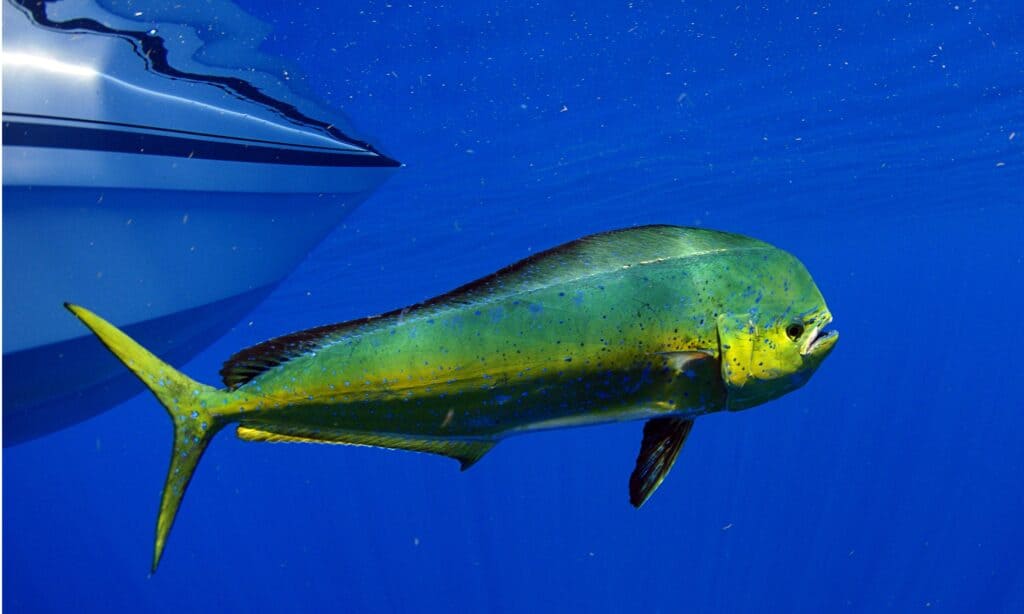
Mahi-mahi is also known as dolphinfish.
©iStock.com/FtLaudGirl
Also known as the common dolphinfish, the mahi-mahi has a distinctive appearance and a rich golden, blue, and greenish coloration. Additionally, their Spanish common name is “dorado,” which fittingly translates to “golden.” Although they grow very quickly and can eventually weigh over 40 pounds, they typically only live for around five years.
4. Mahseer (45+ species: Tor, Neolissochilus, Naziritor, Parator genera)

The golden mahseer is one of more than 45 species of mahseer fish.
©Topimages/Shutterstock.com
Mahseers are incredibly diverse fish that range widely in size, shape, color, and overall appearance. This has historically made classifying them taxonomically a bit confusing. The more than 45 unique species of mahseers are popular both as game fish and food. As members of the carp family, they are highly opportunistic hunters, feeding on anything from other fish and amphibians to fruit and algae.
5. Mail-Cheeked Fish (Scorpaeniformes: 25+ families)
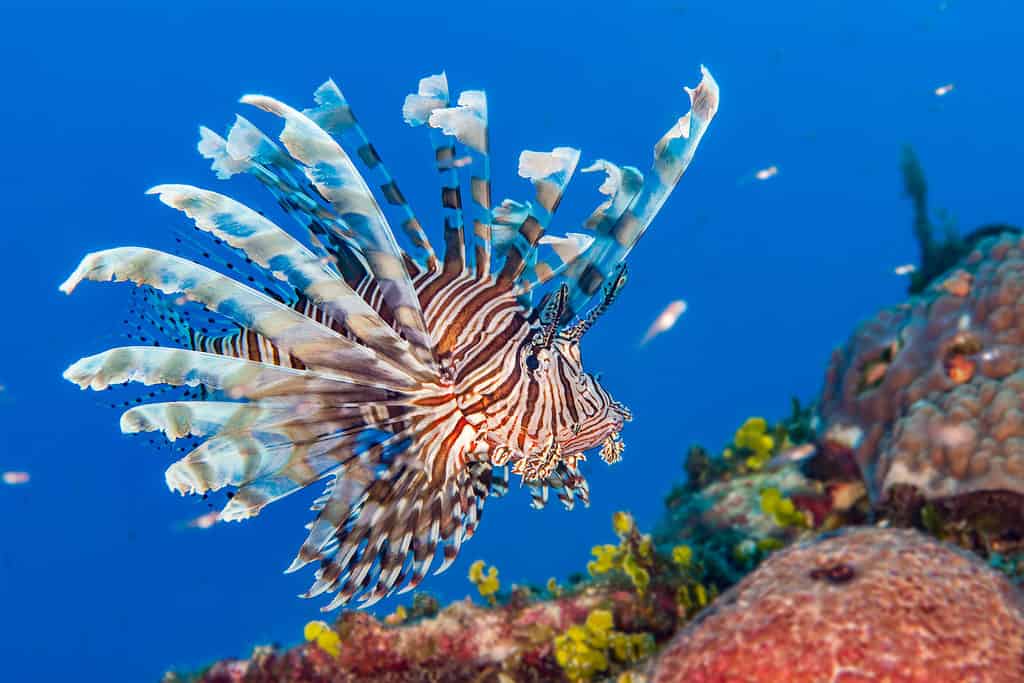
The common lionfish is one of over 1,000 unique species of mail-cheeked fish.
©bearacreative/Shutterstock.com
Mail-cheeked fishes get their common collective name from the hard, armor-like plates of bone running down either side of their faces. Many species also have large, flared, venomous spines protruding from their cheeks, like the well-known common lionfish. There are around 1,300 distinct species of mail-cheeked fishes. They range in size from just a few centimeters long to around three feet.
6. Mako Shark (2 species: Isurus oxyrinchus, Isurus paucus)

The shortfin mako shark is one of the two main species of mako sharks.
©wildestanimal/Shutterstock.com
The two species of mako sharks are some of the fastest sharks in the ocean! In particular, the shortfin mako shark often swims at a steady speed of around 30 miles per hour, though it can swim in short bursts up to 45 miles per hour. Highly predatory, both known species are expert hunters that feed on a wide range of ocean animals, from squids and smaller fish like mackerel to larger animals like sea turtles and dolphins.
7. Mandarinfish/Mandarin Goby (Synchiropus splendidus)
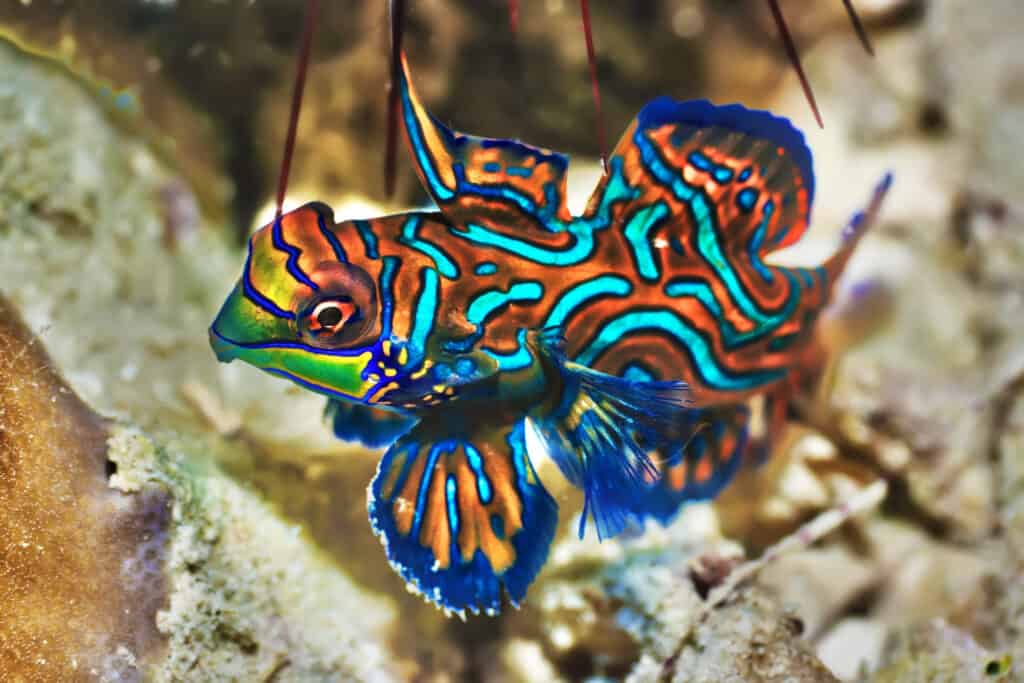
The mandarin fish is a popular aquarium fish thanks to its handsome, vibrant coloration.
©Khoroshunova Olga/Shutterstock.com
These brightly-colored aquarium fish get their vivid blue markings from a light-reflecting pigment in their cells. It’s also sometimes known as the Mandarin dragonet and the picturesque dragonet, making it part of the dragonet family Callionymidae. It’s native to parts of the Pacific Ocean, with a geographic range extending from Japan’s coasts down to Australia.
8. Manta Ray (Mobula genus, 2 species)

The giant oceanic manta ray is the largest species of ray in the world.
©Aaronejbull87/Shutterstock.com
There are two main species of manta rays: the giant oceanic manta ray, scientific name Mobula birostris, and the much smaller reef manta ray, Mobula alfredi. Both are among the largest species of rays in the world, with the giant oceanic manta ray being the single largest variety worldwide. Its massive wingspan can reach close to 30 feet wide, and especially large specimens can have a total body weight nearing 4,000 pounds. Interestingly, giant manta rays are also highly intelligent, with the average individual’s brain weighing close to half a pound.
9. Marbled Lungfish (Protopterus aethiopicus)
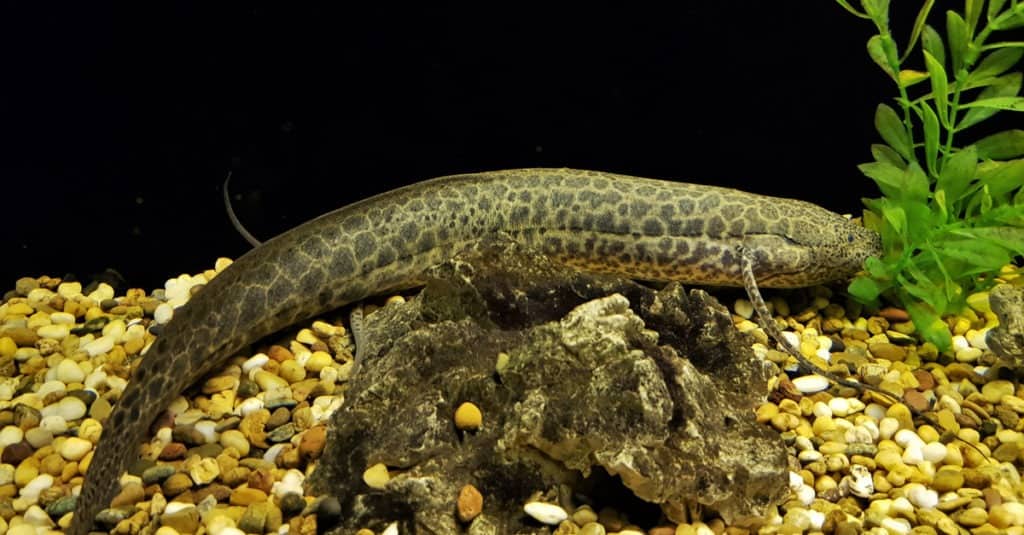
The marbled lungfish is one of six total species of lungfish.
©Arunee Rodloy/Shutterstock.com
The marbled lungfish gets its common name from the many dark gray and brown irregular splotches all over its body, which gives it an elegantly mottled pattern. Like most species of lungfish, they can technically breathe air, but they mainly rely on aquatic respiration. Though they are born with external gills, marbled lungfish undergo a metamorphosis and lose said gills at around three months old.
10. Marlin (Istiophoridae family, 10 species)
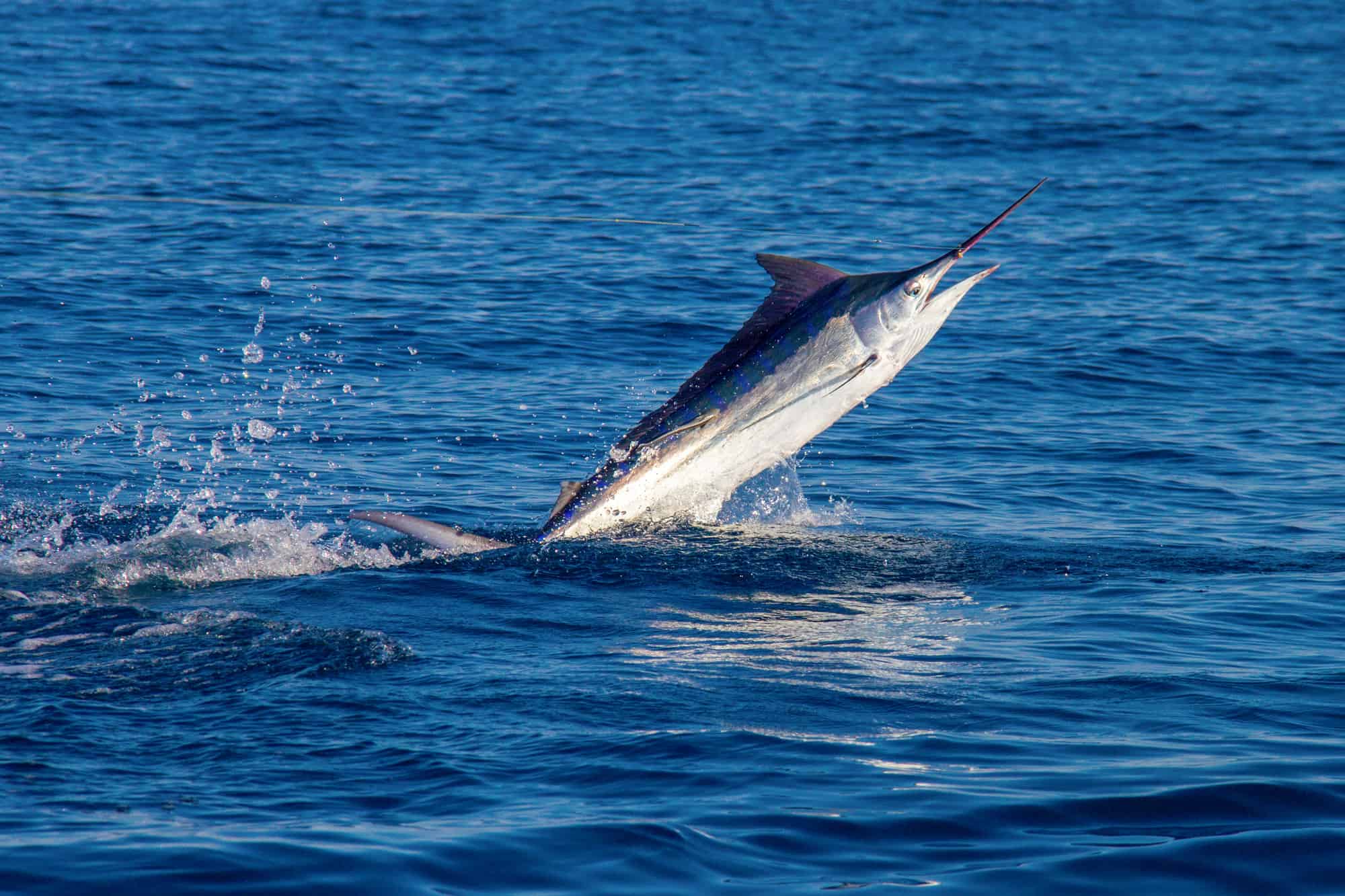
The black marlin is among the fastest fish in the world.
©kelldallfall/Shutterstock.com
The 10 known species of marlins get their common name from their long, extremely narrow snouts that resemble marlinspikes used by sailors in ropework. Their tall, firm dorsal fins extend down their backs and from a crest. As you might imagine, they are closely related to swordfish. Even though they are incredibly speedy swimmers, several of the larger varieties like the Atlantic blue marlin are unfortunately endangered due to overfishing.
11. Masu Salmon (Oncorhynchus masou)
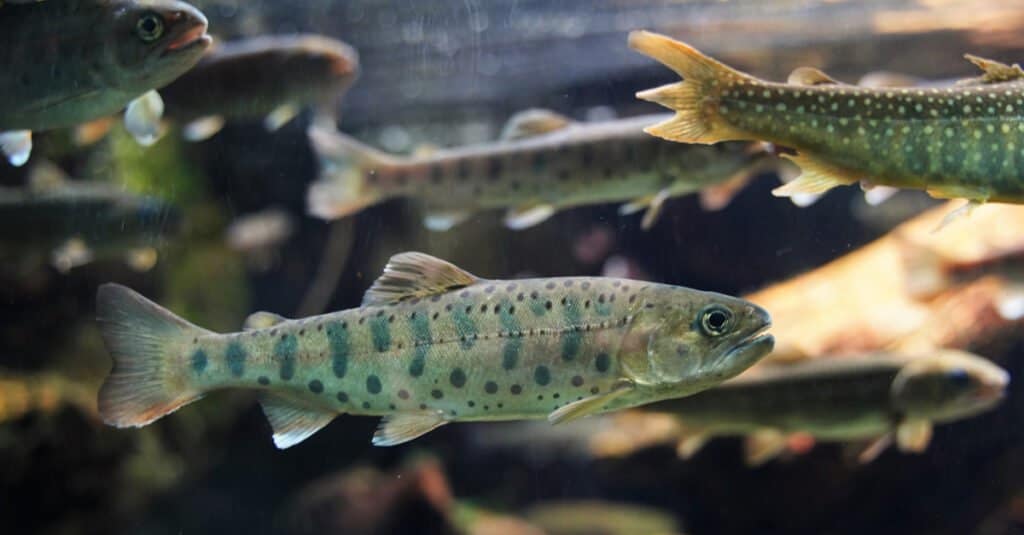
The masu salmon is also commonly known as the cherry trout.
©dokosola/Shutterstock.com
The next fish species starting with M on our list is the Masu salmon, or “trout salmon” in Japanese. Despite taxonomically being classed as a species of salmon, it is commonly known as the cherry trout in Japan, where it is a popular game fish and food fish. There are two potential and often-debated sources of its fruit-themed alternative name, one of which is the dark reddish stripes running down its back, giving it a rich, cherry-toned coloration. Its peak fishing season also occurs at the same time as cherry blossom season in late March through April.
12. Medaka (Oryzias latipes)
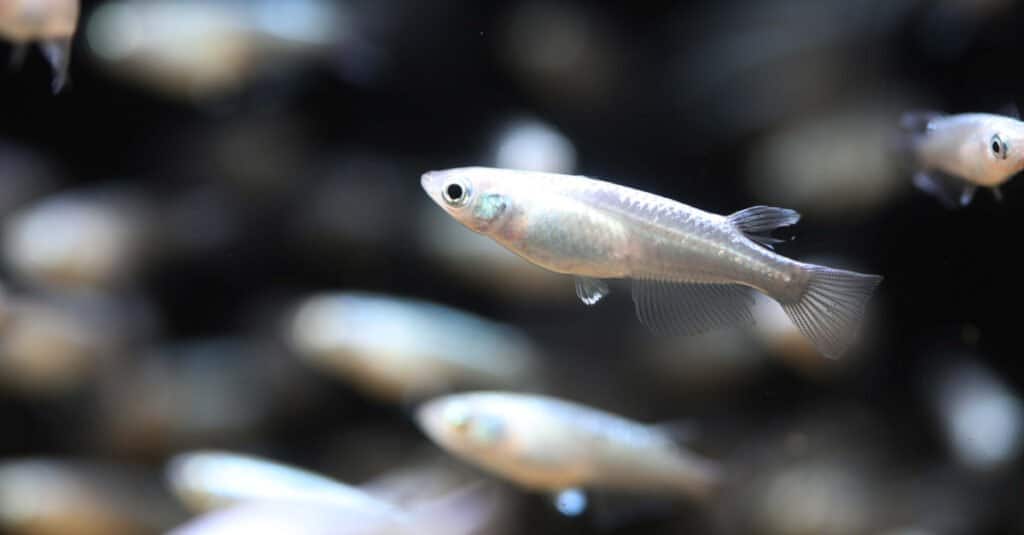
Medaka is also known as ricefish. They are often found in rice paddies.
©Pavaphon Supanantananont/Shutterstock.com
Another important fish species in Japan is the medaka. It is alternatively sometimes known as the Japanese ricefish. Ricefish often live in rice paddies in part due to their small size of just around 1.5 inches when fully grown. Furthermore, they are quite hardy despite being so tiny and can thrive in both brackish and freshwater conditions. The medaka’s manageable size and care requirements, hardiness, and handsomely varying coloration have made it a popular aquarium fish in Japan and elsewhere.
13. Megamouth Shark (Megachasma pelagios)

A megamouth shark specimen on display at Toba Aquarium, Japan. Megamouths are incredibly reclusive, and little is known about them.
©opencage / CC BY-SA 2.5 – License
The megamouth shark is without a doubt one of the most bizarre-looking sharks on the planet due to its enormous mouth that can be over four feet wide. As a deep-sea filter feeder, though, very little is known about the reclusive yet gentle species, and less than 100 specimens have been examined since its discovery in 1976.
14. Menhaden (Brevoortia and Ethmidium genera, 7 species)
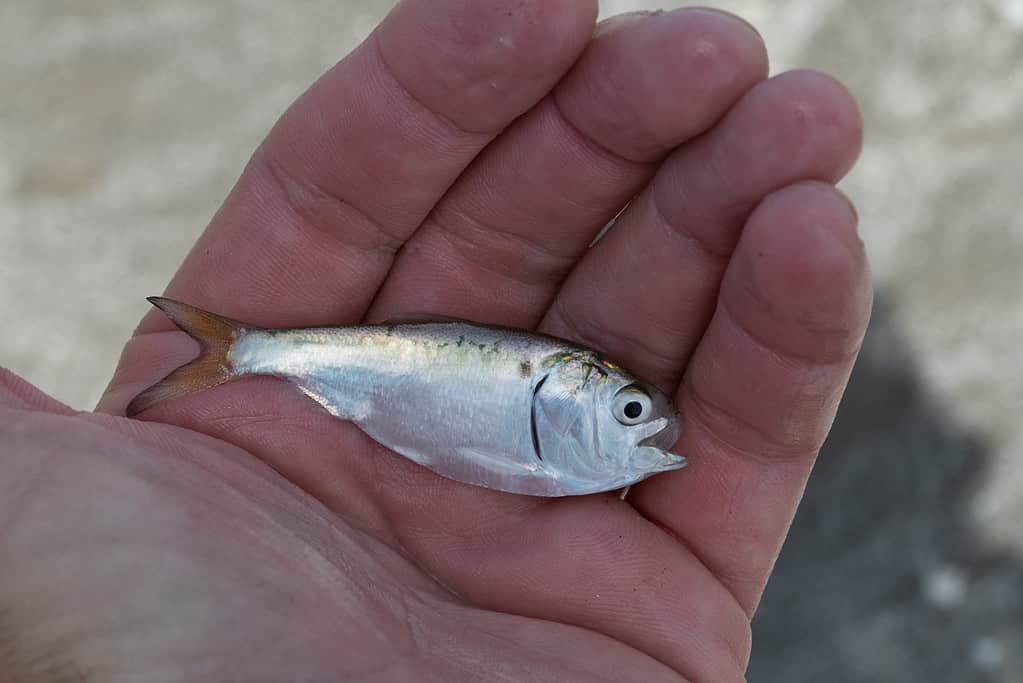
The gulf menhaden is commonly used as bait by anglers.
©iStock.com/Kevin McDonald
The seven total species of menhaden are often regarded as one of the “most important fish in the sea” due to their key role in many species’ diets. Furthermore, menhaden also significantly lessen the effects of toxic algae colonies on numerous species of fish by filter-feeding on the phytoplankton that causes them to bloom. Though they aren’t directly useful as food for humans, they are often processed into fish oil and fish meal used for supplements and food for livestock.
15. Merluccid Hake (Merlucciidae family)

There are more than a dozen species of merluccid hakes.
©Klopping/Shutterstock.com
Related to other saltwater fish like cod and haddock, merluccid hakes have long, narrow bodies that can reach up to 5 feet in length. They prefer muddy, cold water conditions, and most species dwell at depths of at least 150 feet. They mainly feed on other, smaller fish, and many varieties are fished commercially for food.
16. Moonlighter (Tilodon sexfasciatus)

Moonlighters are native to southern Australia.
©Steven Giles/Shutterstock.com
The moonlighter fish is easily recognizable thanks to its rich, pale silvery-toned body that is accented by many bold, vertical black stripes. Its rather tall, spiny dorsal fin often sports a yellowish tinge. The species is native to southern Australia’s coast, where it mainly lives in rocky coral reefs around 300 feet deep. It’s also a popular aquarium fish due to its attractive coloration.
17. Milkfish (Chanos chanos)

The milkfish is the only living species in both its genus and entire taxonomic family.
©Joys/Shutterstock.com
Although the milkfish is the only living species in its taxonomic family, at least five species of extinct milkfish have been documented. Milkfish live throughout the Indian and Pacific Oceans mainly in tropical offshore waters and estuaries. The species is also the official national fish of the Philippines, where it goes by the common name “bangús.”
18. Minnow (Cyprinidae and Leuciscidae families, 1,000+ species)
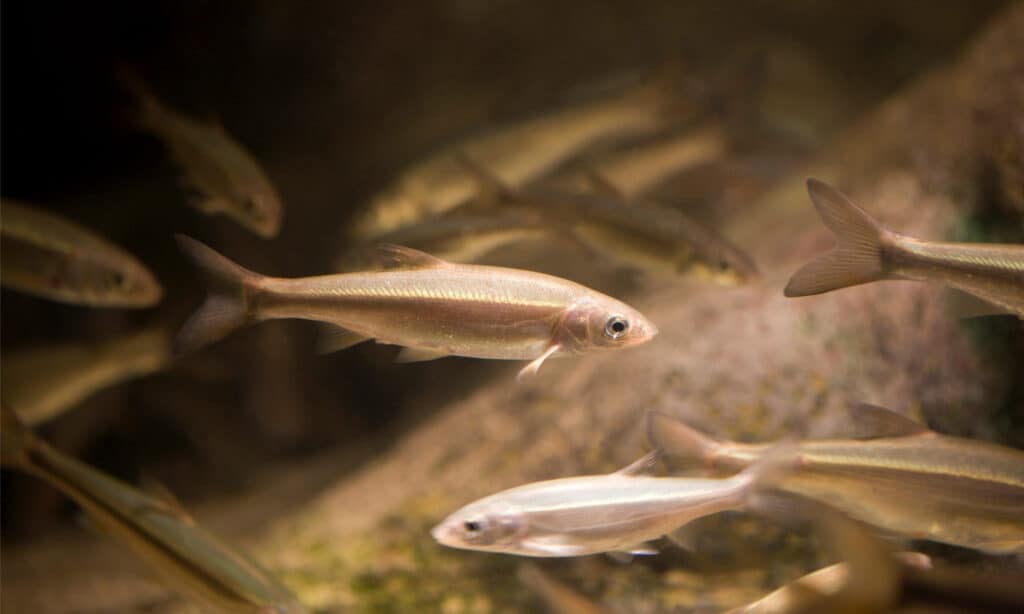
There are over a thousand unique species of minnows.
©iStock.com/y-studio
Tiny yet diverse and incredibly ecologically important, minnows make up more than 1,000 unique species globally. In addition to being popular as bait fish, they are also a crucial food source for thousands of species of fish as well as humans. Most minnow species average just an inch or two long, with very few exceeding four inches in length.
19. Malabar Grouper (Epinephelus malabaricus)

Malabar groupers can reach over seven feet in length.
©Barbara Ash/Shutterstock.com
The Malabar grouper goes by many common names, including the giant rock cod, greasy grouper, speckled grouper, and blackspot rock cod, just to name a handful. Though these large, bulky fish can reach more than seven feet long, most mature specimens average around 35 to 40 inches in length. Interestingly, they are hermaphrodites that by default initially function sexually as females, only to eventually switch their sex to male later in life.
20. Mexican Tetra (Astyanax mexicanus)

As cave-dwellers, Mexican tetras are often totally blind.
©Kuttelvaserova Stuchelova/Shutterstock.com
Despite being born with eyes, Mexican tetras usually end up completely blind by the time they are adults. As they age, their tiny, barely functioning eyes regress and degenerate until they essentially disappear. Fortunately, these spooky-looking fish don’t need eyes to navigate and instead rely on a system of sensory organs known as lateral lines. These help Mexican tetras gauge distance to and from other fish, plants, and objects as well as detect vibrations and changes in water pressure.
21. Mojarra (Gerreidae family, 50+ species)
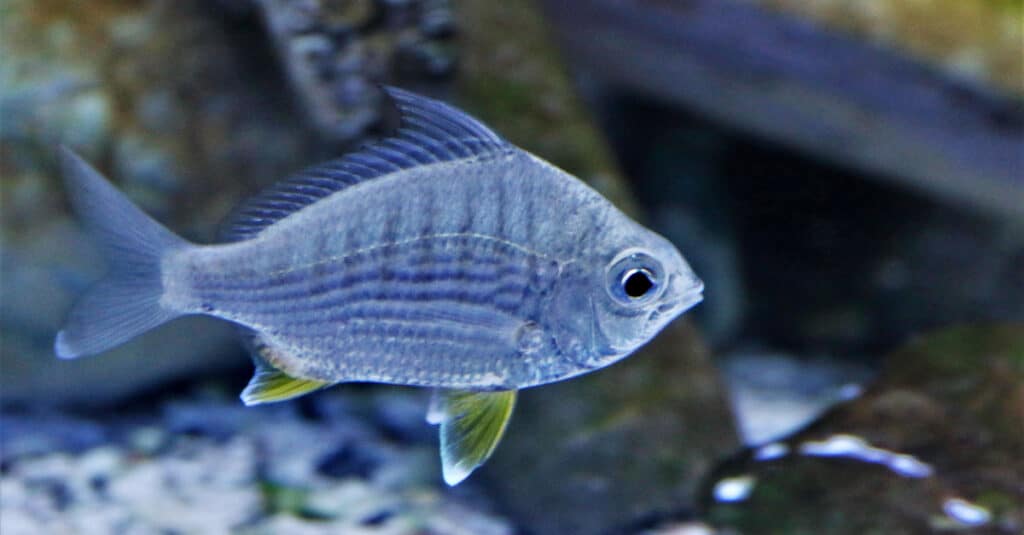
The deep-bodied mojarra can live in saltwater and brackish water.
©Arunee Rodloy/Shutterstock.com
There are more than 50 species of mojarras worldwide. They mainly live in shallow, tropical coastal waters but can also tolerate brackish and freshwater environments. Most species range from around 5 to 10 inches long when mature, but some can reach more than 15 inches in length. Thanks in part to their small size and abundance, they are a popular bait fish in South America, the Caribbean, and parts of North America.
22. Mola (Molidae family, 5 species)
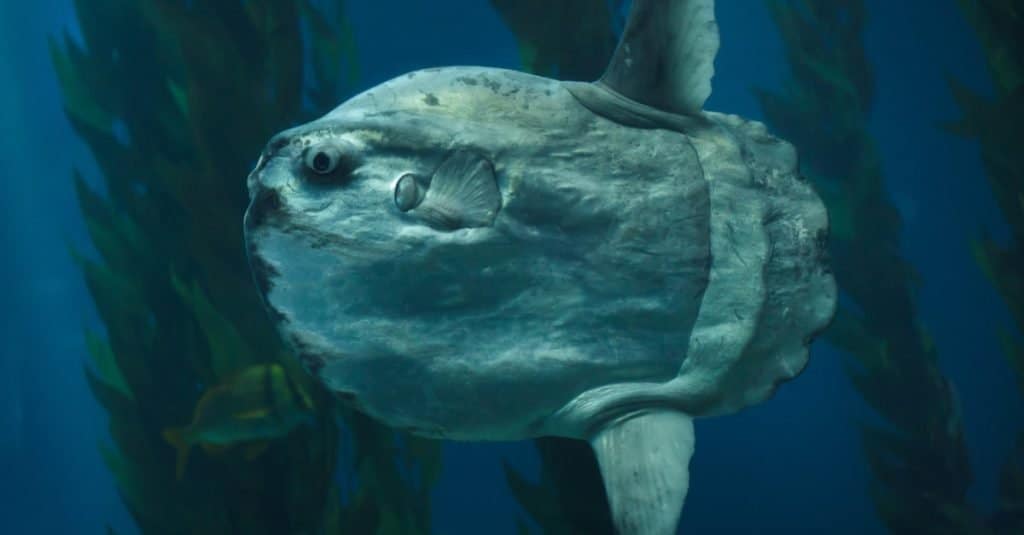
Molas like the
mola mola
, also known as the ocean sunfish, are slow, awkward swimmers.
©Vladimir Wrangel/Shutterstock.com
Molas are among the largest fish starting with the letter M on our list! Incredibly, especially large molas can weigh upwards of 5,000 pounds and measure over 10 feet long. They are quite easy to recognize thanks to their distinctively wide, flat appearance. Due to this unusual and awkward body shape, though, they are slow, poor swimmers who often end up riddled with aquatic parasites.
23. Molly (Poecilia sphenops)
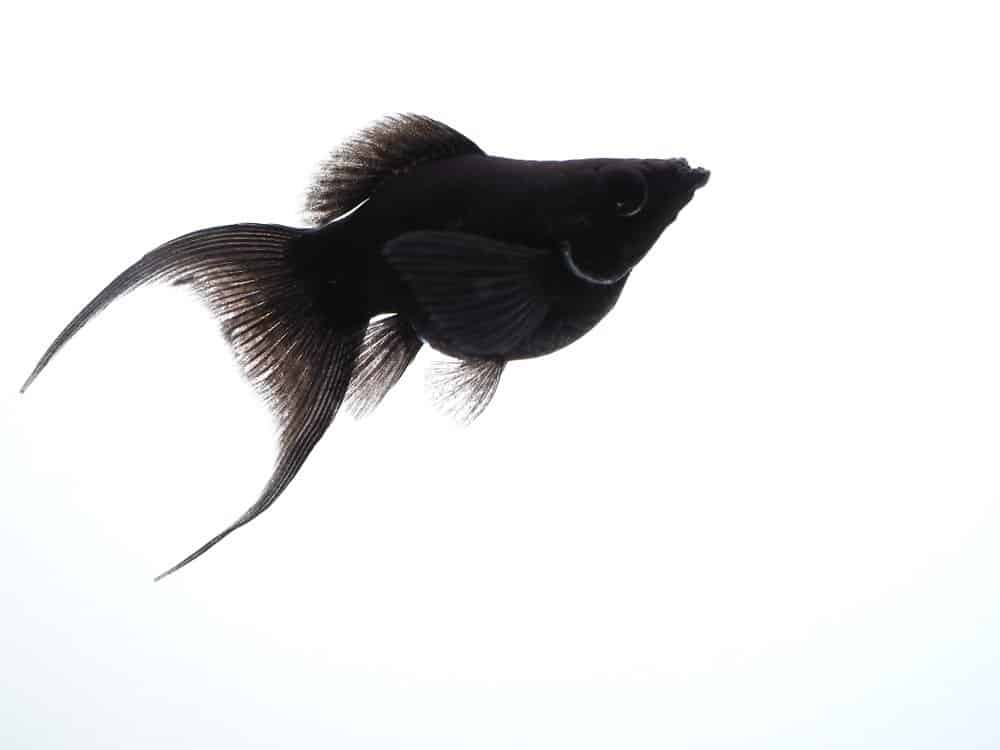
The common molly is one of around 40 unique species of mollies within the
Poeciliagenus.
©Palomasius/Shutterstock.com
There are around 40 unique species of mollies, but the common molly is perhaps the most well-known. This is largely due to its popularity as an aquarium fish. Native to Mexico and Colombia’s coastlines, they are hardy and can tolerate both brackish and saltwater conditions. They’re also commonly used as feeder fish for other, larger aquarium fish and various species of amphibians. On average, they measure just three to five inches long.
24. Midas Cichlid (Amphilophus citrinellus)
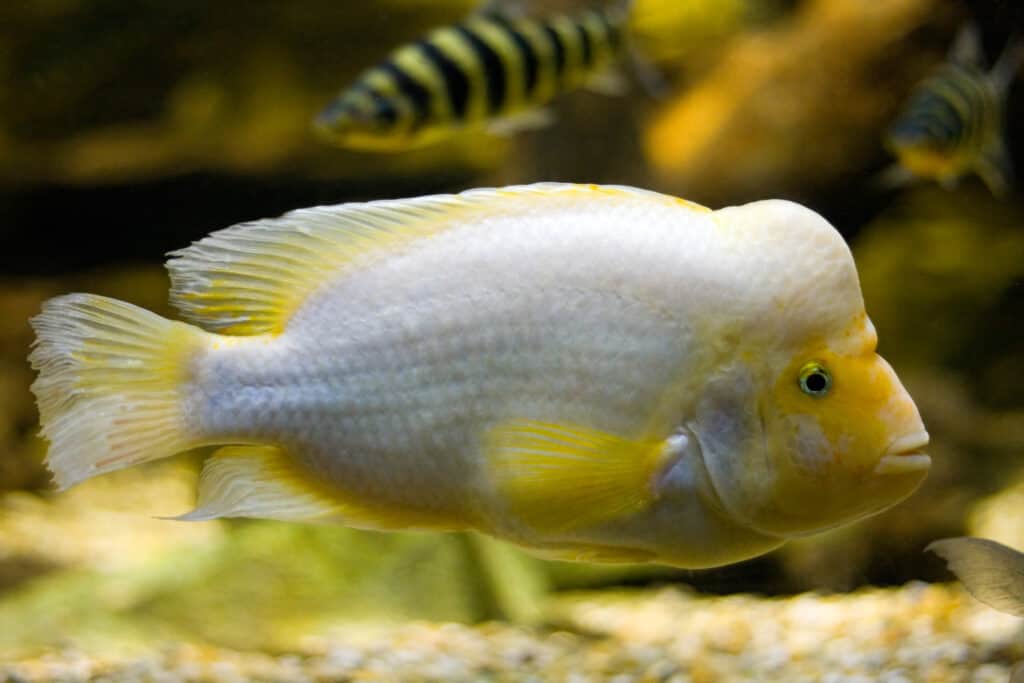
Midas cichlids are popular aquarium fish, but they can be aggressive.
©kostudio/Shutterstock.com
True to its rather regal-sounding name, the Midas cichlid is often a rich, golden yellow. However, its exact coloration can vary, with some specimens being more grayish or brown, while others can have varying shades of pink, orange, and off-white. Many individuals also have prominent nuchal humps or round protrusions of soft tissue atop their head similar to a crest.
25. Monkfish (Lophius genus, 7 species)
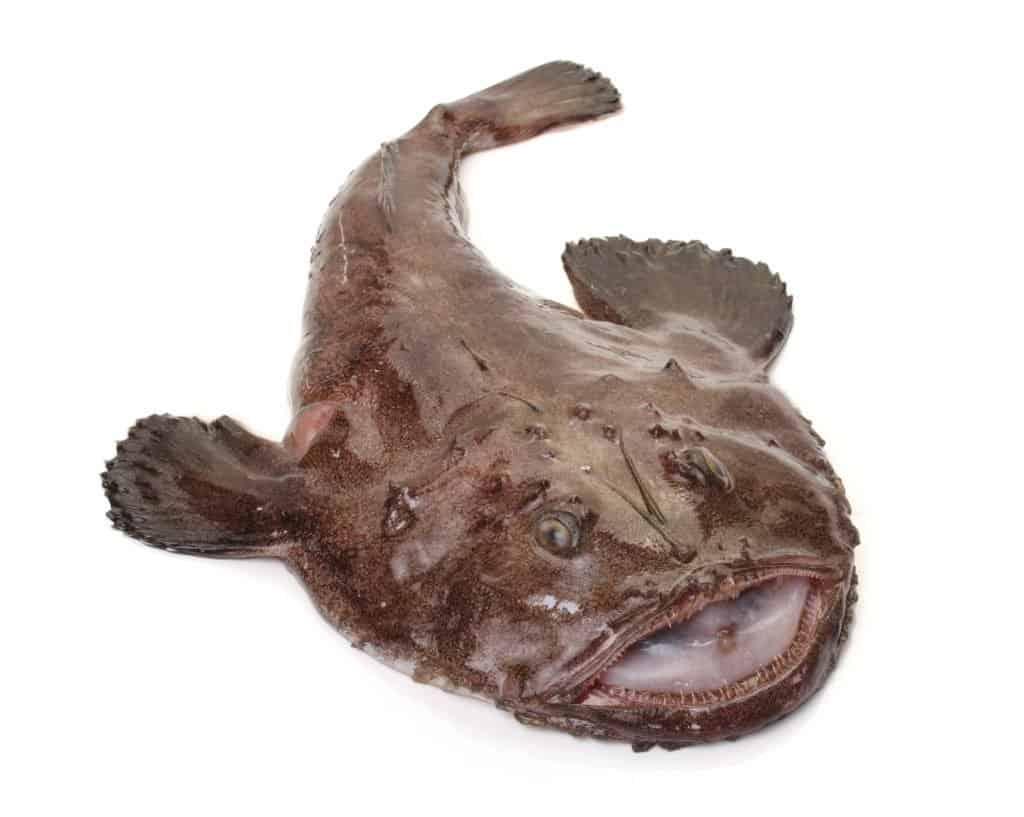
There are seven unique species of monkfish.
©zcw/Shutterstock.com
The monkfish’s wide, flat body and massive mouth full of long, razor-sharp teeth give it a fearsome appearance. There are seven total species of monkfish, and the largest varieties can grow to over four feet long and weigh nearly 50 pounds. All known varieties are deep-sea dwellers that frequent ocean depths of anywhere from 300 to more than 3,000 feet.
26. Moorish Idol (Zanclus cornutus)
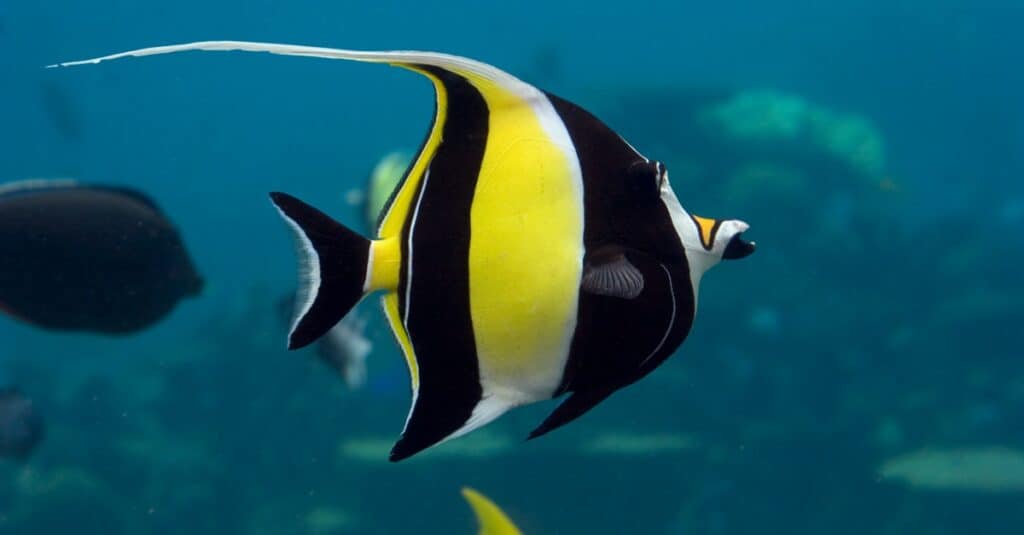
The Moorish idol is the only member of its entire taxonomic family.
©iStock.com/qldian
If you’re a Disney fan, you might recognize the Moorish idol from Finding Nemo, as the character Gill happens to be one of these colorful fish. Thanks to their long, elegant, ribbon-like dorsal fin and vibrant yellow and blue striped coloration, they have historically been popular as aquarium fish. They are, however, very fragile and extremely difficult to care for, so they should only be reserved for expert aquarists.
27. Mangrove Snapper (Lutjanus griseus)
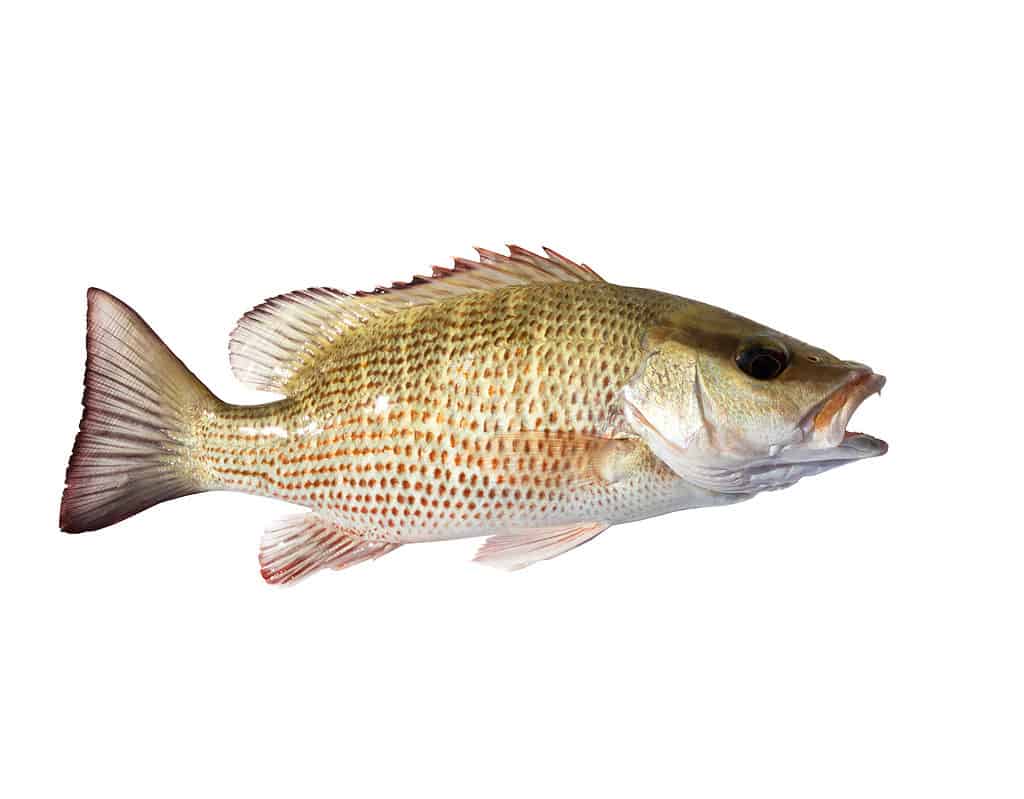
Mangrove snappers can live in both brackish and freshwater.
©IrinaK/Shutterstock.com
Also known as the gray snapper for its grayish-red coloration, the mangrove snapper is one of around 110 total species of snapper fish within the Lutjanidae family. Though its exact color and patterning can vary, most specimens are easy to recognize due to the single thick, dark stripe extending horizontally across each eye. They can reach 35 inches long and weigh over 40 pounds.
28. Moray Eel (Muraenidae family, 200+ species)

There are more than 200 unique species of moray eels.
©iStock.com/Vitalii Kalutskyi
Moray eels are far more diverse than most people would think, consisting of more than 200 species spanning 15 different genera. While most varieties are saltwater fish, some can also survive in brackish and freshwater conditions. Morays are fearsome, highly opportunistic predators that feed on all kinds of fish, as well as certain crustaceans and cephalopods like octopuses and squids.
29. Mosquitofish (Gambusia affinis)
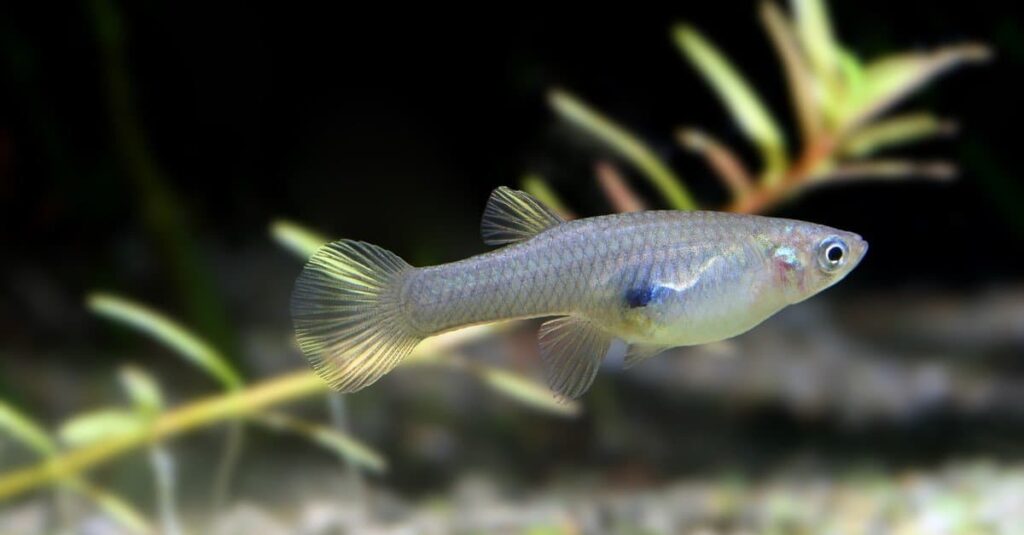
Mosquitofish commonly eat mosquito larvae.
©topimages/Shutterstock.com
The mosquitofish gets its common name from its affinity for feeding on mosquito larvae. However, their full diet is quite diverse, and they mainly feed on zooplankton, insects, and other small, aquatic invertebrates. Mostly gray or silver in color, the average mosquitofish measures only around 1.5 to 3 inches long.
30. Mudfish (Amia calva)

Also known as bowfins, mudfish have existed for more than 200 million years.
©IrinaK/Shutterstock.com
The mudfish is considered by many ichthyologists to be a living fossil, as the species has changed very little morphologically throughout the 200 million years or so of its existence. It is also commonly known as the bowfin due to its long, curved, bow-like dorsal fin. Its elongated, somewhat bulky body can grow to nearly 30 inches long and weigh over 20 pounds.
31. Mudskipper (Oxudercinae subfamily, 23 species)
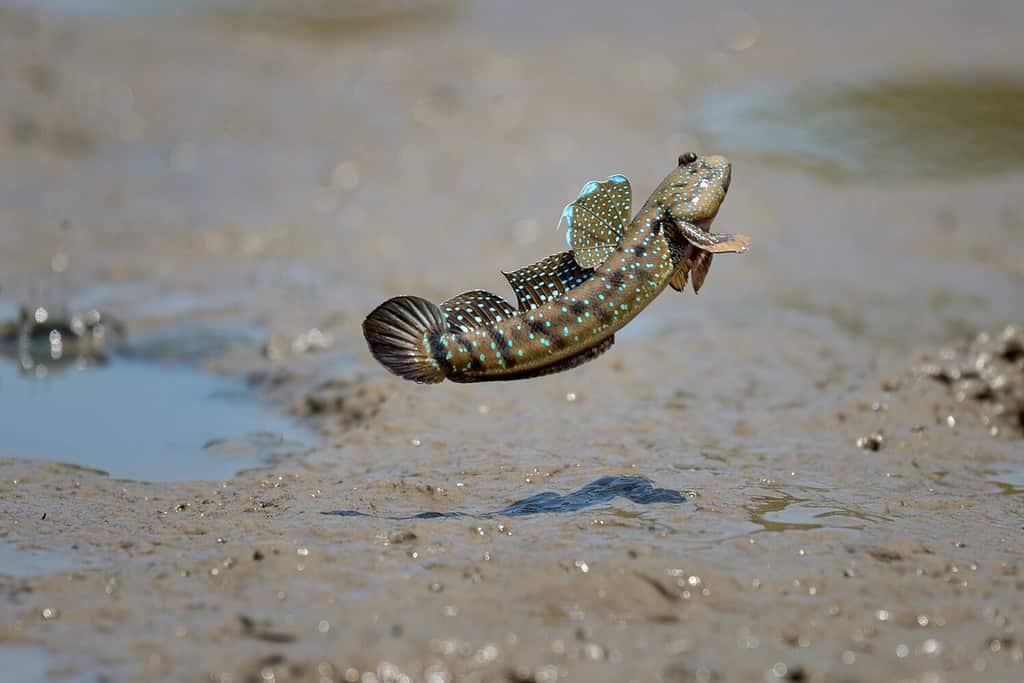
Mudskippers are members of the goby family, Oxudercidae.
©Anake Seenadee/Shutterstock.com
As their common name implies, mudskippers can walk and jump on land and even survive out of water for several weeks at a time. Although they’re technically members of the Goby family, they’re unique as far as gobies go. They can easily clear more than two feet of distance in one single leap, and they can even “climb” small trees and ledges if necessary.
32. Mummichog (Fundulus heteroclitus)
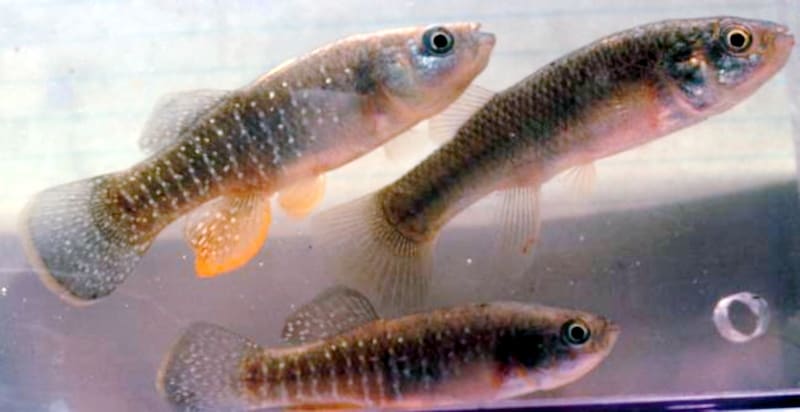
The mummichog is one of around 1,200 species of killifish.
©NOAA / public domain – License
The mummichog’s unique common name is Algonquian in origin. More specifically, it’s a Narragansett term that essentially translates to “moving in crowds,” which refers to the species’ tendency to form shoals. This small variety of killifish averages 3 to 6 inches long and is native to much of North America’s Atlantic coast.
33. Madagascar Rainbowfish (Bedotia madagascariensis)

The Madagascar rainbowfish, as its name implies, is native to Madagascar. It is a common aquarium fish.
©iStock.com/Mirko_Rosenau
The Madagascar rainbowfish is one of around 50 total freshwater rainbowfish species. As their name suggests, rainbowfish are vibrant and have a wide range of possible colors, patterns, and markings. In particular, the Madagascar rainbowfish is popular amongst aquarists as it fares quite well in captivity, is modest in size at around 4 to 6 inches long, and is attractive to have on display. It is native not only to Madagascar but also to Australia, New Guinea, and the Indonesian island of Sulawesi.
34. Muskellunge (Esox masquinongy)

The muskellunge is the largest member of the pike family.
©Engbretson, Eric / U.S. Fish and Wildlife Service, Public domain, via Wikimedia Commons – License
The muskellunge gets its common name from the Ojibwe word “maashkinoozhe,” which loosely translates to “great fish.” The name is rather fitting, as the muskellunge is the largest member out of all seven species within the pike family, Esocidae. These massive freshwater fish have elongated, narrow, almost eel-like bodies that are bulkier than they look, often weighing upwards of 25 pounds or more.
35. Mustache Triggerfish (Balistoides viridescens)

Also known as the titan triggerfish, the mustache triggerfish has sharp teeth and is quite aggressive.
©Vitaliy 6447/Shutterstock.com
Also known as the titan or giant triggerfish, the mustache triggerfish is one of the largest varieties of triggerfish out of around 40 total species. Aggressive, territorial, and equipped with defenses like sharp dorsal spines and a mouth full of long, sharp teeth, this colorful fish is a fierce predator. It feeds on animals like sea urchins, coral, crustaceans, and mollusks with ease.
The Largest Fish That Starts with M

The giant manta ray can measure up to 30 feet long and weigh up to 6,000 pounds.
©Aaronejbull87/Shutterstock.com
There are two main contenders for the largest fish starting with M on our list: the mola mola and the giant manta ray.
By weight, the mola mola and giant manta are quite close in size. While most typical molas weigh between 500 and 2,500 pounds, especially large individuals can weigh over 5,000 pounds. Meanwhile, the giant manta ray just slightly edges ahead of these measurements, as it can weigh anywhere from 3,000 to 6,000 pounds.
In terms of length, both fish are also astonishingly massive. Mola molas are around six feet long on average, while their fin-to-fin length can reach just over eight feet long. Manta rays, by comparison, can grow to be nearly 30 feet long if you include their long, slender tail.
Fish That Start With M At a Glance: Common and Scientific Names
| Common Name | Scientific Name |
|---|---|
| Mackerel | Scombridae family and Scombrini tribe, 30+ species |
| Mackerel Shark | Lamna genus, 2 species: Lamna ditropis, Lamna nasus |
| Mahi-Mahi, Common dolphinfish | Coryphaena hippurus |
| Mahseer | Cyprinidae family, 4 genera, 45+ species |
| Mail-Cheeked Fish | Scorpaeniformes order, 25 families, 1,400+ species |
| Mako Shark | Isurus genus, 2 species: Isurus oxyrinchus, Isurus paucus |
| Mandarinfish/Mandarin Goby | Synchiropus picturatus |
| Manta Ray | Mobula genus, 2 species: Mobula birostris, Mobula alfredi |
| Marbled Lungfish | Protopterus aethiopicus |
| Marlin | Istiophoridae family, 10 species |
| Masu Salmon | Oncorhynchus masou |
| Medaka | Oryzias latipes |
| Megamouth Shark | Megachasma pelagios |
| Menhaden | Brevoortia and Ethmidium genera, 7 species |
| Merluccid Hake | Merlucciidae family |
| Moonlighter | Tilodon sexfasciatus |
| Milkfish | Chanos chanos |
| Minnow | Cyprinidae and Leuciscidae families, 1,000+ species |
| Malabar Grouper | Epinephelus malabaricus |
| Mexican Tetra | Astyanax mexicanus |
| Mojarra | Gerreidae family, 50+ species |
| Mola | Molidae family, 5 species |
| Molly (Common) | Poecilia sphenops |
| Midas Cichlid | Amphilophus citrinellus |
| Monkfish | Lophius genus, 7 species |
| Moorish Idol | Zanclus cornutus |
| Mangrove Snapper | Lutjanus griseus |
| Moray Eel | Muraenidae family, 200+ species |
| Mosquitofish | Gambusia affinis |
| Mudfish | Amia calva |
| Mudskipper | Oxudercinae subfamily, 23 species |
| Mummichog | Fundulus heteroclitus |
| Madagascar Rainbowfish | Bedotia madagascariensis |
| Muskellunge | Esox masquinongy |
| Mustache Triggerfish | Balistoides viridescens |
The photo featured at the top of this post is © kelldallfall/Shutterstock.com
Thank you for reading! Have some feedback for us? Contact the AZ Animals editorial team.






